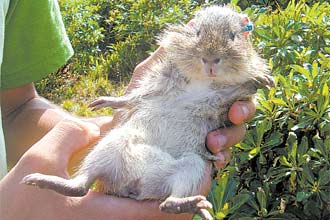Note the tiny flat face with forward looking eyes and still unchanged hair growth pattern with old eye location so evident that many fail to even notice the tiny (small as a thumb nail) flat face with close spaced eyes on first glance. Nose is now just a vertical slit on the center line, not two slightly separated nostrils which also provide some information about predator’s direction of approach as seen in your photo below this one.
Note the very different eye locations of the animal in your photograph below, which look from the sides of the head for nearly 360 vision to spot approaching predators:
Your animal also clearly is not on a tiny island that is 90% rocks barely above sea level at high tide.
Your animal is, however identified as “cavia-intermedia” so probably the first photograph’s animal has no scientific name yet. Neither I nor the newspaper reported who first broke the news of the Preá’s existence to the public are experts in scientific nomenclature. My photo comes from his article as does most of the information I have posted, after translating it into English. If you can read Portuguese, here is link to that now 2 year old article:
http://www1.folha.uol.com.br/folha/ciencia/ult306u536537.shtml My sciforum posts very likely are the first reports in English.
Regardless of the scientific name, (or lack thereof) these are photos of two very different animals and the differences in size, hind leg shape, eye location are all exactly what one would expect evolutionary pressure on the tiny 90% rock island to produce when many even slightly genetically less well adapted animals in any generation starve to death due to over breeding* and lack of food for more than 40 or 42 animals being the only control (no predators) on population.
To reverse Shakespeare’s “A rose by any other name is still a rose.” Note that the guinea pig (2nd photo) and the Preá (1st Photo) are different animals /species, even if still called the same name. Just as dog and cats would be even if both were if called “cadogs.” Different names do not different species make. – lack of fertile interbreeding possibility does that.
-------------
*female can make 4 or more offspring at least three times each year, so during summer rainy season population may swell to 60 or so, but most will die - Mainly only those with slight genetic advantage live for an entire year. Fantastically strong evolutionary selective pressure continuously applied for 8000 years made the new specie in record setting time for a mammal. (Bacterial can do that in 24 hours - why you must keep taking your anti-biotic for 10 days even if you feel "well" after three.)


